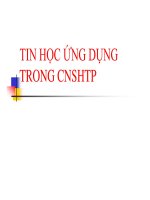Tin học ứng dụng trong công nghệ hóa học Parallelprocessing 13 matrixmultiplication
Bạn đang xem bản rút gọn của tài liệu. Xem và tải ngay bản đầy đủ của tài liệu tại đây (387.43 KB, 23 trang )
Matrix Multiplication
Thoai Nam
Outline
Sequential matrix multiplication
Algorithms for processor arrays
– Matrix multiplication on 2-D mesh SIMD model
– Matrix multiplication on hypercube SIMD model
Matrix multiplication on UMA
multiprocessors
Matrix multiplication on multicomputers
Khoa Công Nghệ Thông Tin – Đại Học Bách Khoa Tp.HCM
-2-
Sequential Matrix Multiplication
Global a[0..l-1,0..m-1], b[0..m-1][0..n-1], {Matrices to be multiplied}
c[0..l-1,0..n-1],
{Product matrix}
t,
{Accumulates dot product}
i, j, k;
Begin
for i:=0 to l-1 do
for j:=0 to n-1 do
t:=0;
for k:=0 to m-1 do
t:=t+a[i][k]*b[k][j];
endfor k;
c[i][j]:=t;
endfor j;
endfor i;
End.
Khoa Coâng Nghệ Thông Tin – Đại Học Bách Khoa Tp.HCM
-3-
Algorithms for Processor
Arrays
Matrix multiplication on 2-D mesh SIMD model
Matrix multiplication on Hypercube SIMD model
Khoa Công Nghệ Thông Tin – Đại Học Bách Khoa Tp.HCM
-4-
Matrix Multiplication on
2D-Mesh SIMD Model
Gentleman(1978) has shown that multiplication of
two n*n matrices on the 2-D mesh SIMD model
requires 0(n) routing steps
We will consider a multiplication algorithm on a 2D mesh SIMD model with wraparound
connections
Khoa Công Nghệ Thông Tin – Đại Học Bách Khoa Tp.HCM
-5-
Matrix Multiplication on
2D-Mesh SIMD Model (cont’d)
For simplicity, we suppose that
– Size of the mesh is n*n
– Size of each matrix (A and B) is n*n
– Each processor Pi,j in the mesh (located at row i,
column j) contains ai,j and bi,j
At the end of the algorithm, Pi,j will hold the
element ci,j of the product matrix
Khoa Công Nghệ Thông Tin – Đại Học Bách Khoa Tp.HCM
-6-
Matrix Multiplication on
2D-Mesh SIMD Model (cont’d)
Major phases
b0,3
a0,0
b0,0
a0,1
b0,1
a0,2
b0,2
a0,3
b0,3
a1,0
b1,0
a1,1
b1,1
a1,2
b1,2
a1,3
b1,3
a2,0
b2,0
a2,1
b2,1
a2,2
b2,2
a2,3
b2,3
a3,0
b3,0
a3,1
b3,1
a3,2
b3,2
a3,3
b3,3
(a) Initial distribution
of matrices A and B
a3,0
b0,2
b1,3
b0,1
b1,2
b2,3
a0,0
b0,0
a0,1
b1,1
a0,2
b2,2
a0,3
b3,3
a1,0
a1,1
b1,0
a1,2
b2,1
a1,3
b3,2
a2,0
a2,1
a2,2
b2,0
a2,3
b3,1
a3,1
a3,2
a3,3
b3,0
(b) Staggering all A’s elements
in row i to the left by i positions
and all B’s elements in col j
upwards by i positions
Khoa Công Nghệ Thông Tin – Đại Học Bách Khoa Tp.HCM
-7-
Matrix Multiplication on
2D-Mesh SIMD Model (cont’d)
b0,3
a1,0
a3,0
b0,2
b1,3
b0,1
b1,2
b2,3
a0,0
b0,0
a0,1
b1,1
a0,2
b2,2
a0,3
b3,3
a1,1
b1,0
a1,2
b2,1
a1,3
b3,2
a2,3
b3,1
a2,0
a2,1
a2,2
b2,0
a3,1
a3,2
a3,3
b3,0
(b) Staggering all A’s elements
in row i to the left by i positions
and all B’s elements in col j
upwards by i positions
Each processor P(i,j) has a
pair of elements to multiply
ai,k and bk,j
a0,0
b0,0
a0,1
b1,1
a0,2
b2,2
a0,3
b3,3
a1,1
b1,0
a1,2
b2,1
a1,3
b3,2
a1,0
b0,3
a2,2
b2,0
a2,3
b3,1
a2,0
b0,2
a2,1
b1,3
a3,3
b3,0
a3,0
b0,1
a3,1
b1,2
a3,2
b2,3
(c) Distribution of 2 matrices A
and B after staggering in a 2-D
mesh with wrapparound
connection
Khoa Công Nghệ Thông Tin – Đại Học Bách Khoa Tp.HCM
-8-
Matrix Multiplication on
2D-Mesh SIMD Model (cont’d)
The rest steps of the algorithm from the viewpoint of processor P(1,2)
b3,2
b2,2
a1,1
a1,2
a1,3
a1,0
a1,2
a1,3
a1,0
a1,1
b3,2
b0,2
b0,2
b1,2
b1,2
b2,2
(a) First scalar multiplication step
(b) Second scalar multiplication step
after elements of A are cycled to the
left and elements of B are cycled
upwards
Khoa Coâng Nghệ Thông Tin – Đại Học Bách Khoa Tp.HCM
-9-
Matrix Multiplication on
2D-Mesh SIMD Model (cont’d)
b1,2
b0,2
a1,3
a1,0
a1,1
a1,2
a1,0
a1,1
a1,2
a1,3
b1,2
b2,2
b2,2
b3,2
b3,2
b0,2
(c) Third scalar multiplication step after
second cycle step
(d) Third scalar multiplication step after
second cycle step. At this point
processor P(1,2) has computed the
dot product c1,2
Khoa Coâng Nghệ Thông Tin – Đại Học Bách Khoa Tp.HCM
-10-
Matrix Multiplication on
2D-Mesh SIMD Model (cont’d)
Detailed Algorithm
Stagger 2 matrices
a[0..n-1,0..n-1] and b[0..n-1,0..n-1]
Global n, {Dimension of matrices}
k;
Local a, b, c;
Begin
for k:=1 to n-1 do
forall P(i,j) where 1 ≤ i,j < n do
if i ≥ k then a:= fromleft(a);
if j ≥ k then b:=fromdown(b);
end forall;
endfor k;
Khoa Công Nghệ Thông Tin – Đại Học Baùch Khoa Tp.HCM
-11-
Matrix Multiplication on
2D-Mesh SIMD Model (cont’d)
Compute dot product
forall P(i,j) where 0 ≤ i,j < n do
c:= a*b;
end forall;
for k:=1 to n-1 do
forall P(i,j) where 0 ≤ i,j < n do
a:= fromleft(a);
b:=fromdown(b);
c:= c + a*b;
end forall;
endfor k;
End.
Khoa Công Nghệ Thông Tin – Đại Học Bách Khoa Tp.HCM
-12-
Matrix Multiplication on
2D-Mesh SIMD Model (cont’d)
Can we implement the above mentioned algorithm
on a 2-D mesh SIMD model without wrapparound
connection?
Khoa Coâng Nghệ Thông Tin – Đại Học Bách Khoa Tp.HCM
-13-
Matrix Multiplication Algorithm
for Multiprocessors
Design strategy 5
– If load balancing is not a problem, maximize grain size
Grain size: the amount of work performed between
processor interactions
Things to be considered
– Parallelizing the most outer loop of the sequential
algorithm is a good choice since the attained grain size
(0(n3/p)) is the biggest
– Resolving memory contention as much as possible
Khoa Công Nghệ Thông Tin – Đại Học Bách Khoa Tp.HCM
-14-
Matrix Multiplication Algorithm
for UMA Multiprocessors
Algorithm using p processors
Global n,
a[0..n-1,0..n-1], b[0..n-1,0..n-1];
c[0..n-1,0..n-1];
Local i,j,k,t;
Begin
forall Pm where 1 ≤ m ≤ p do
for i:=m to n step p do
for j:= 1 to n to
t:=0;
for k:=1 to n do t:=t+a[i,k]*b[k,j];
endfor j;
c[i][j]:=t;
endfor i;
end forall;
End.
{Dimension of matrices}
{Two input matrices}
{Product matrix}
Khoa Công Nghệ Thông Tin – Đại Học Baùch Khoa Tp.HCM
-15-
Matrix Multiplication Algorithm
for NUMA Multiprocessors
Things to be considered
– Try to resolve memory contention as much as possible
– Increase the locality of memory references to reduce
memory access time
Design strategy 6
– Reduce average memory latency time by increasing
locality
The block matrix multiplication algorithm is a
reasonable choice in this situation
– Section 7.3, p.187, Parallel Computing: Theory and Practice
Khoa Công Nghệ Thông Tin – Đại Học Bách Khoa Tp.HCM
-16-
Matrix Multiplication Algorithm
for Multicomputers
We will study 2 algorithms on multicomputers
– Row-Column-Oriented Algorithm
– Block-Oriented Algorithm
Khoa Công Nghệ Thông Tin – Đại Học Bách Khoa Tp.HCM
-17-
Row-Column-Oriented
Algorithm
The processes are organized as a ring
– Step 1: Initially, each process is given 1 row of the matrix
A and 1 column of the matrix B
– Step 2: Each process uses vector multiplication to get 1
element of the product matrix C.
– Step 3: After a process has used its column of matrix B, it
fetches the next column of B from its successor in the
ring
– Step 4: If all rows of B have already been processed,
quit. Otherwise, go to step 2
Khoa Công Nghệ Thông Tin – Đại Học Bách Khoa Tp.HCM
-18-
Row-Column-Oriented
Algorithm (cont’d)
Why do we have to organize processes as a ring
and make them use B’s rows in turn?
Design strategy 7:
– Eliminate contention for shared resources by changing
the order of data access
Khoa Công Nghệ Thông Tin – Đại Học Bách Khoa Tp.HCM
-19-
Row-Column-Oriented
Algorithm (cont’d)
Example: Use 4 processes to mutliply two matrices A4*4 and B4*4
A
B
C
A
B
C
A
B
C
1st iteration
A
B
C
Khoa Công Nghệ Thông Tin – Đại Học Baùch Khoa Tp.HCM
-20-









